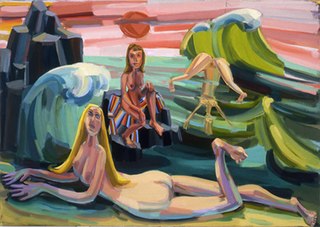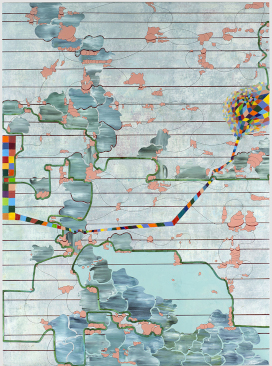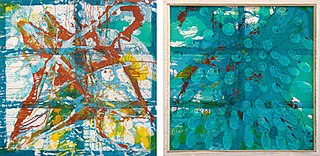Related Research Articles

Amy Sillman is a New York-based visual artist, known for process-based paintings that move between abstraction and figuration, and engage nontraditional media including animation, zines and installation. Her work draws upon art historical tropes, particularly postwar American gestural painting, as both influences and foils; she engages feminist critiques of the discourses of mastery, genius and power in order to introduce qualities such as humor, awkwardness, self-deprecation, affect and doubt into her practice. Profiles in The New York Times, ARTnews, Frieze, and Interview, characterize Sillman as championing "the relevance of painting" and "a reinvigorated mode of abstraction reclaiming the potency of active brushwork and visible gestures." Critic Phyllis Tuchman described Sillman as "an inventive abstractionist" whose "messy, multivalent, lively" art "reframes long-held notions regarding the look and emotional character of abstraction."

Yun-Fei Ji is a Chinese-American painter who has been based largely in New York City since 1990. His art synthesizes old and new representational modes, subverting the classical idealism of centuries-old Chinese scroll and landscape painting traditions to tell contemporary stories of survival amid ecological and social disruption. He employs metaphor, symbolic allusion and devices such as caricature and the grotesque to create tumultuous, Kafka-esque worlds that writers suggest address two cultural revolutions: the first, communist one and its spiritual repercussions, and a broader capitalist one driven by industrialization and its effects, both in China and the US. ARTnews critic Lilly Wei wrote, "Ancestral ghosts and skeletons appear frequently in Ji’s iconography; his work is infused with the supernatural and the folkloric as well as the documentary as he records with fierce, focused intensity the displacement and forced relocation of people, the disappearance of villages, and the environmental upheavals of massive projects like the controversial Three Gorges Dam."
Lois Dodd, is an American painter and educator. Dodd was a key member of New York's postwar art scene. She played a large part and was involved in the wave of modern artists including Alex Katz and Yvonne Jacquette who explored the coast of Maine in the latter half of the 20th century.
Stephen Westfall is an American painter, critic, and professor at Rutgers University and Bard College.

Katherine Bradford, née Houston, is an American artist based in New York City, known for figurative paintings, particularly of swimmers, that critics describe as simultaneously representational, abstract and metaphorical. She began her art career relatively late and has received her widest recognition in her seventies. Critic John Yau characterizes her work as independent of canon or genre dictates, open-ended in terms of process, and quirky in its humor and interior logic.

Peter Plagens is an American artist, art critic, and novelist based in New York City. He is most widely known for his longstanding contributions to Artforum and Newsweek, and for what critics have called a remarkably consistent, five-decade-long body of abstract formalist painting. Plagens has written three books on art, Bruce Nauman: The True Artist (2014), Moonlight Blues: An Artist's Art Criticism (1986) and Sunshine Muse: Modern Art on the West Coast, 1945-70 (1974), and two novels, The Art Critic (2008) and Time for Robo (1999). He has been awarded major fellowships for both his painting and his writing. Plagens's work has been featured in surveys at the Museum of Modern Art, Los Angeles County Museum of Art (LACMA), Whitney Museum, and PS1, and in solo exhibitions at the Hirshhorn Museum and Las Vegas Art Museum. In 2004, the USC Fisher Gallery organized and held a 30-year traveling retrospective of his work. Critics have contrasted the purely visual dialogue his art creates—often generating more questions than answers—with the directness of his writing; they also contend that the visibility of his bylines as a critic has sometimes overshadowed his artmaking—unduly. Los Angeles Times critic David Pagel described Plagens's painting as a "fusion of high-flying refinement and everyday awkwardness" with an intellectual savvy, disdain for snobbery and ungainliness he likened to Willem de Kooning's work. Reviewing Plagens's 2018 exhibition, New York Times critic Roberta Smith called the show an "eye-teasing sandwich of contrasting formalist strategies," the hard-won result of a decade of focused experimentation.

Barbara Takenaga is an American artist known for swirling, abstract paintings that have been described as psychedelic and cosmic, as well as scientific, due to their highly detailed, obsessive patterning. She gained wide recognition in the 2000s, as critics such as David Cohen and Kenneth Baker placed her among a leading edge of artists renewing abstraction with paintings that emphasized visual beauty and excess, meticulous technique, and optical effects. Her work suggests possibilities that range from imagined landscapes and aerial maps to astronomical and meteorological phenomena to microscopic views of cells, aquatic creatures or mineral cross-sections. In a 2018 review, The New Yorker described Takenaga as "an abstractionist with a mystic’s interest in how the ecstatic can emerge from the laborious."
Jiha Moon is a contemporary artist who focuses on painting, printmaking, and sculptural ceramic objects. Born in Daegu, South Korea, Moon is currently based in Tallahassee, Florida, after years of living and working in Atlanta, Georgia. She joined Florida State University's Art department faculty in the fall of 2023.
Gandy Brodie was an American painter working primarily in New York City and Townshend, Vermont, during the middle part of the 20th century. He had ties to Abstract Expressionism through artists such as Willem de Kooning and his style, though singular, was considered second-generation Abstract Expressionism. His paintings were influenced by the works of artists such as Camille Corot, Paul Cézanne, Vincent van Gogh, Piet Mondrian, Chaïm Soutine, Georges Rouault, Pablo Picasso, and Paul Klee. Shane Brody, his only child, is a jazz and Americana guitarist who resides in Underhill, Vermont.

Judith Linhares is an American painter, known for her vibrant, expressive figurative and narrative paintings. She came of age and gained recognition in the Bay Area culture of the 1960s and 1970s and has been based in New York City since 1980. Curator Marcia Tucker featured her in the influential New Museum show, "'Bad' Painting" (1978), and in the 1984 Venice Biennale show, "Paradise Lost/Paradise Regained: American Visions of the New Decade." Linhares synthesizes influences including Expressionism, Bay Area Figuration, Mexican modern art and second-wave feminism, in work that flirts with abstraction and balances visionary personal imagery, expressive intensity, and pictorial rigor. Art historian Whitney Chadwick wrote, "Linhares is an artist for whom painting has always mattered as the surest path of synthesizing experience and interior life," her works "emerging as if by magic from an alchemical stew of vivid complementary hues and muted tonalities." Critic John Yau describes her paintings "funny, strange, and disconcerting," while writer Susan Morgan called them "unexpected and indelible" images exploring "an oddly sublime territory where exuberant bliss remains inseparable from ominous danger."

Lisa Corinne Davis is an American visual artist known for abstract paintings and works on paper that suggest maps and other encoded forms of knowledge. She employs abstraction as a means of rendering the complexities of contemporary experience—including her own as an African-American woman—often questioning preconceived notions about identity, classification, and rationality versus subjectivity. Her densely layered, colorful work merges contrasting schemas, visual elements and formal languages, blurring distinctions between figuration and abstraction, real and fictive spaces and concepts, and microcosmic or macrocosmic reference. Brooklyn Rail critic Joan Waltemath wrote, "The urban experiences of space and time that Davis presents are subtle distillations of moment and coincidence ... Her attempt to map the shattered terrain of contemporary life points both to an awareness of other times and a belief in navigating the present one."

Dona Nelson is an American painter, best known for immersive, gestural, primarily abstract works employing unorthodox materials, processes and formats to disrupt conventional notions of painting and viewership. A 2014 New Yorker review observed, "Nelson gives notice that she will do anything, short of burning down her house to bully painting into freshly spluttering eloquence." Since 2002, long before it became a more common practice, Nelson has produced free-standing, double-sided paintings that create a more complex, conscious viewing experience. According to New York Times critic Roberta Smith, Nelson has dodged the burden of a "superficially consistent style," sustained by "an adventuresome emphasis on materials" and an athletic approach to process that builds on the work of Jackson Pollock. Writers in Art in America and Artforum credit her experimentation with influencing a younger generation of painters exploring unconventional techniques with renewed interest. Discussing one of Nelson's visceral, process-driven works, curator Klaus Kertess wrote, the paint-soaked "muslin is at once the tool, the medium, and the made."
Chie Fueki is a Japanese American painter. She has had an active career exhibiting her work in commercial galleries, and has been awarded a Guggenheim Foundation Fellowship. Fueki's intricate paintings combine influences from both Eastern and Western traditions. She currently lives and works in Beacon, New York.
Mary Lum is an American visual artist whose paintings, collages and works on paper reference the urban environment, architectural forms and systems. Critic John Yau writes, "Mary Lum’s paintings on paper are based on collages, which are made from things she uses or encounters in her everyday life as well as photographs she takes of the places she visits. "

Joanna Pousette-Dart is an American abstract artist, based in New York City. She is best known for her distinctive shaped-canvas paintings, which typically consist of two or three stacked, curved-edge planes whose arrangements—from slightly precarious to nested—convey a sense of momentary balance with the potential to rock, tilt or slip. She overlays the planes with meandering, variable arabesque lines that delineate interior shapes and contours, often echoing the curves of the supports. Her work draws on diverse inspirations, including the landscapes of the American Southwest, Islamic, Mozarabic and Catalan art, Chinese landscape painting and calligraphy, and Mayan art, as well as early and mid-20th-century modernism. Critic John Yau writes that her shaped canvasses explore "the meeting place between abstraction and landscape, quietly expanding on the work of predecessors", through a combination of personal geometry and linear structure that creates "a sense of constant and latent movement."

Louise Belcourt is a Canadian-American artist based in New York, known for elusive, largely abstract paintings that blend modernist formal play, a commitment to the physical world, and a visual language that shifts between landscape and the body, architecture and geometric form. New York Times critic Ken Johnson writes of her earlier work, "balancing adroitly between Color Field abstraction and Pop-style representation, Ms. Belcourt's paintings invite meditation on the perceptual, the conceptual and how our minds construct the world." Describing her later evolution, David Brody writes in Artcritical, "Hard-nosed Canadian empiricism and Brooklyn grit seem to combine in Belcourt’s work to undermine stylistic stasis."
Anna Conway is an American visual artist based in New York City and known for enigmatic oil paintings that depict uneasy, absurdist moments descending on isolated, ordinary individuals. She combines a style identified as precise and methodical with detailed observation, "an air of surrealist suspension," and a narrative sense that critics characterize as elusive, metaphysical and "imbued with cinematic suggestion." Conway has exhibited nationally and internationally, including at MoMA PS1, the American Academy of Arts and Letters, Kemper Museum of Contemporary Art, University Art Museum at Albany, Fralin Museum of Art, and Collezione Maramotti (Italy), among other venues. She has been recognized with a Guggenheim Fellowship (2014), two Pollock-Krasner Foundation Awards, and the American Academy of Arts and Letters William L. Metcalf Award (2008).

Harriet Korman is an American abstract painter based in New York City, who first gained attention in the early 1970s. She is known for work that embraces improvisation and experimentation within a framework of self-imposed limitations that include simplicity of means, purity of color, and a strict rejection of allusion, illusion, naturalistic light and space, or other translations of reality. Writer John Yau describes Korman as "a pure abstract artist, one who doesn’t rely on a visual hook, cultural association, or anything that smacks of essentialization or the spiritual," a position he suggests few post-Warhol painters have taken. While Korman's work may suggest early twentieth-century abstraction, critics such as Roberta Smith locate its roots among a cohort of early-1970s women artists who sought to reinvent painting using strategies from Process Art, then most associated with sculpture, installation art and performance. Since the 1990s, critics and curators have championed this early work as unjustifiably neglected by a male-dominated 1970s art market and deserving of rediscovery.

Medrie MacPhee is a Canadian-American painter based in New York City. She works in distinct painting and drawing series that have explored the juncture of abstraction and representation, relationships between architecture, machines, technology and human evolution, and states of flux and transformation. In the 1990s and 2000s, she gained attention for metaphorical paintings of industrial subjects and organic-machine and bio-technological forms. In later work, she explored architectural instability before turning to semiotically dense canvases combining compartments of color and collaged pieces of garments fit together like puzzles, which New York Times critic Roberta Smith described as "powerfully flat, more literal than abstract" with "an adamant, witty physicality."

Sanford Wurmfeld is an American abstract painter. His large-scale works investigate the impact of color on mood and perception using shifts of hue and tone across grids.
References
- ↑ Yau, John (2022-04-13). "Is It an Artificial Paradise or an Artificial Hell or Both?". Hyperallergic. Retrieved 2022-05-15.
- ↑ "Elliott Green at Jonathan Ferrara Gallery". www.artforum.com. Retrieved 2022-05-15.
- ↑ Smith, Lee (Autumn 2000). "Once Upon a Canvas; The Elliott Green Story". Modern Painters.
- 1 2 G, lralon (2019-10-17). "Conversation with Elliott Green". Figure/Ground. Retrieved 2022-05-15.
- ↑ Yau, John (2017-02-26). "Elliott Green Can See for Miles and Miles and Miles". Hyperallergic. Retrieved 2022-05-16.
- ↑ "From Shangri-La to Hell: Elliott Green's Human Nature". Riot Material. 2017-03-05. Retrieved 2022-05-16.
- ↑ Ebony, David; Lucidon, Gary; Prikryl, Jana; Rubiner, Michael; Svenson, Arne; Yau, John (2020). Elliott Green: At the Far Edge of the Known World (PDF). Pierogi Press.
- ↑ BAU Institute
- ↑ "Elliot Green - Artists". Jonathan Ferrara Gallery. Retrieved 2022-05-16.
- ↑ "The Glimpse Series: Artist Elliott Green Explores Depth and Time in Abstract Landscapes". American Academy in Rome. Retrieved 20 June 2022.
- ↑ "1993 fellowships (archived)". John Simon Guggenheim Memorial Fellowship. Archived from the original on 9 November 2013. Retrieved 20 June 2022.
- ↑ "Elliott Green, Untitled". Museum of Contemporary Art, Chicago. Retrieved 20 June 2022.
- ↑ "Elliott Green". Kemper Museum. Retrieved 20 June 2022.
- ↑ "Elliott Green". Shark's Ink. Retrieved 2022-05-15.